I need some advice on my Seas speaker project.
First some background...
I bought these drivers (Seas H149 & H225) several years ago - without knowing anything about DIY speaker design. I put them in a 3.5l ported box based on a rudimentary design using Speaker Workshop IIRC. Needless to say the performance were less than stellar!
Here are pictures of the drivers:
Front view
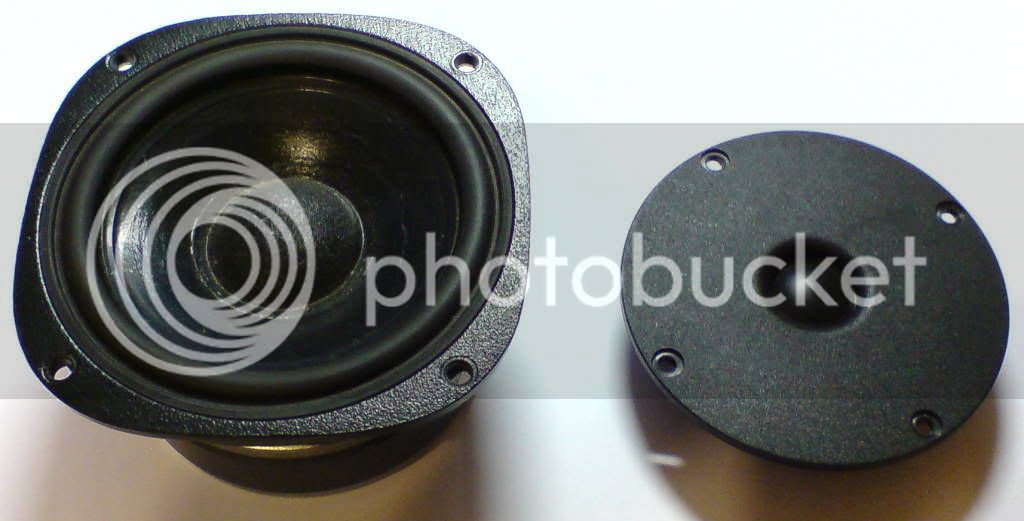
Back view
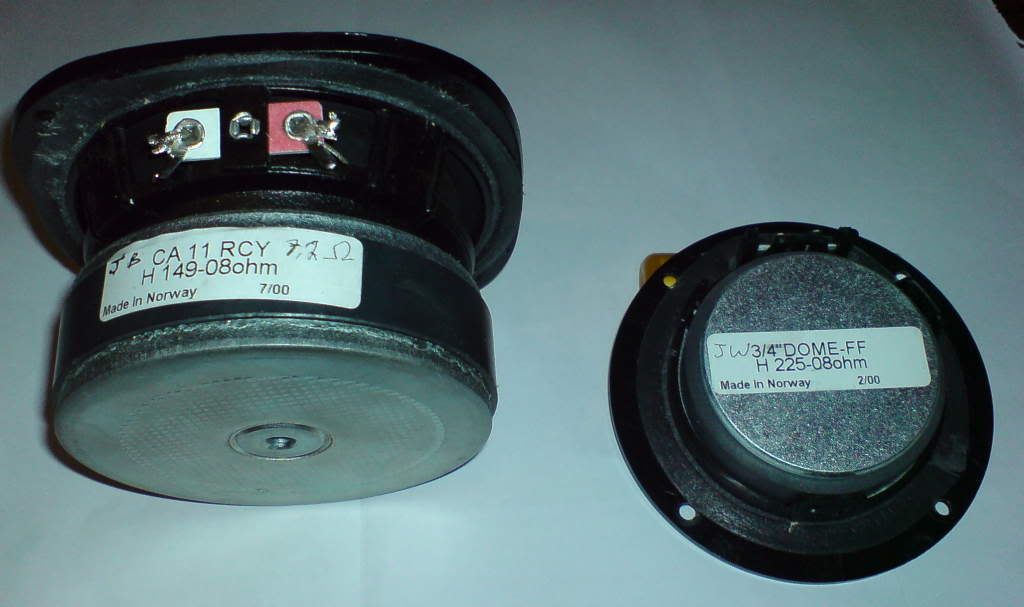
Since then I have upgraded my speaker DIY paraphernalia to the extent that I can now design and build proper speakers (tools wise speaking that is...). I have spent the last several months studying speaker design in general and Sound Easy in particular. As a result I have a lot of theoretical knowledge but very little practical experience, hence the reason for this post.
My idea was to build small surround sound speakers for my HT and since Seas claimed a usable frequency range of 45-5000Hz for the woofer, I thought they'd be able to go down quite low.
I have decided to revisit my "design" (more a "klip in die bos" TBH) using my new tools and knowledge. Here are the results so far...
I started by measuring the H149's using SE's Easylab which includes a MLS tool in order to obtain T/S parameters. The measurements were done with the driver magnet clamped to the edge of a large desk in a vertical position. The reference resistor was 11.4 Ohm. I used the delta V (volume) approach using a 3l enclosure.
Below is the free air impedance plot with the extracted T/S parameters.
H149 Free Air Impedance plot
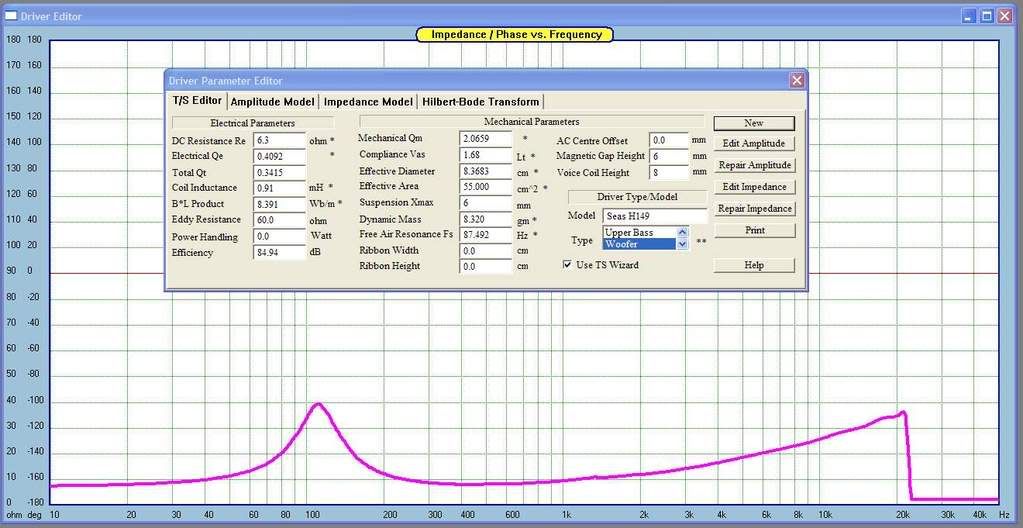
Measured T/S parameters
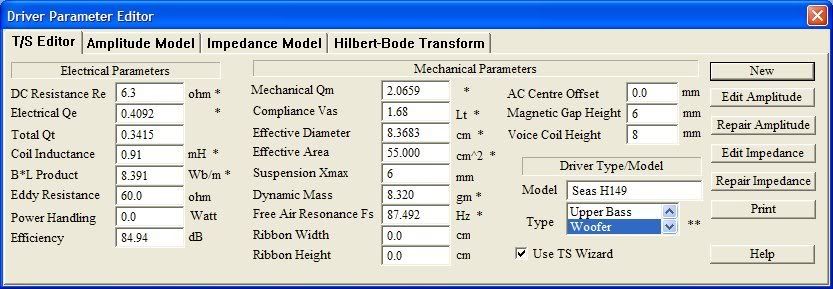
Seas Published T/S parameters
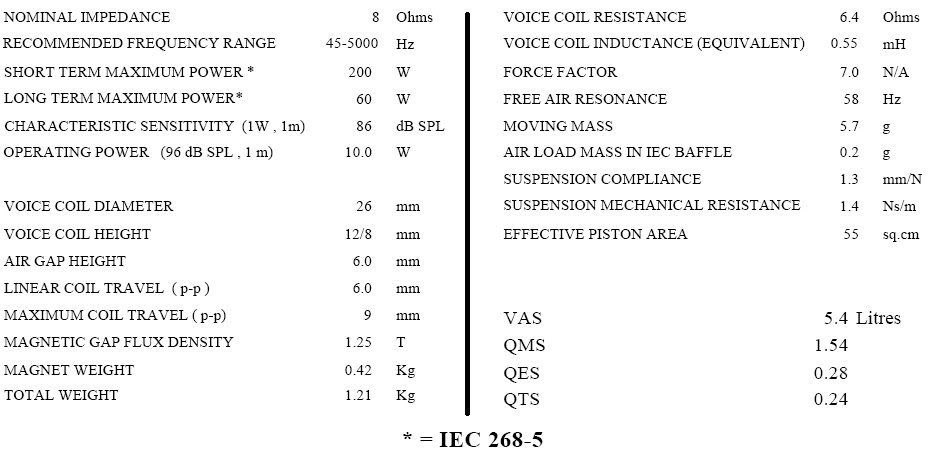
As can be seen there are significant differences between the published vs measured parameters. I based the design on the measured parameters.
I decided on a ported 2l box tuned to 85Hz (This is at the measured driver resonance but I have to get at least some bass extensions - or is this my first mistake?). The actual box is 2.5l to allow for driver motor structure, port volume and crossover components. A 25% increase in box volume is significant but so is the H149's motor! (second mistake?)
Below are the measured impedance and frequency response plots of the H149 mounted in the test enclosure with fiberglass damping (about 2.5cm thick) applied to the sides, top and bottom. The frequency response plot was arrived at by splicing together the following measurements:
1. Gated far field
2. Near field
3. Port
4. Baffle step correction
The frequency response was tailed by performing a Hilbert-Bode transform.
H149 Boxed (2.5l) Impedance plot
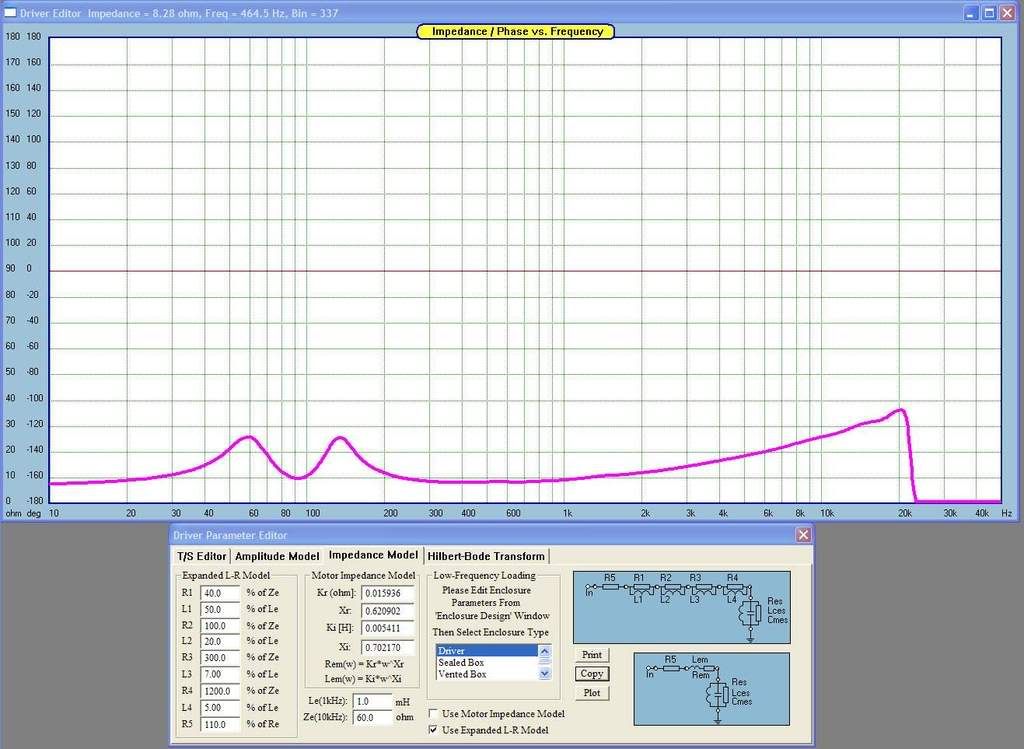
H149 Boxed (2.5l) Frequency Response plot
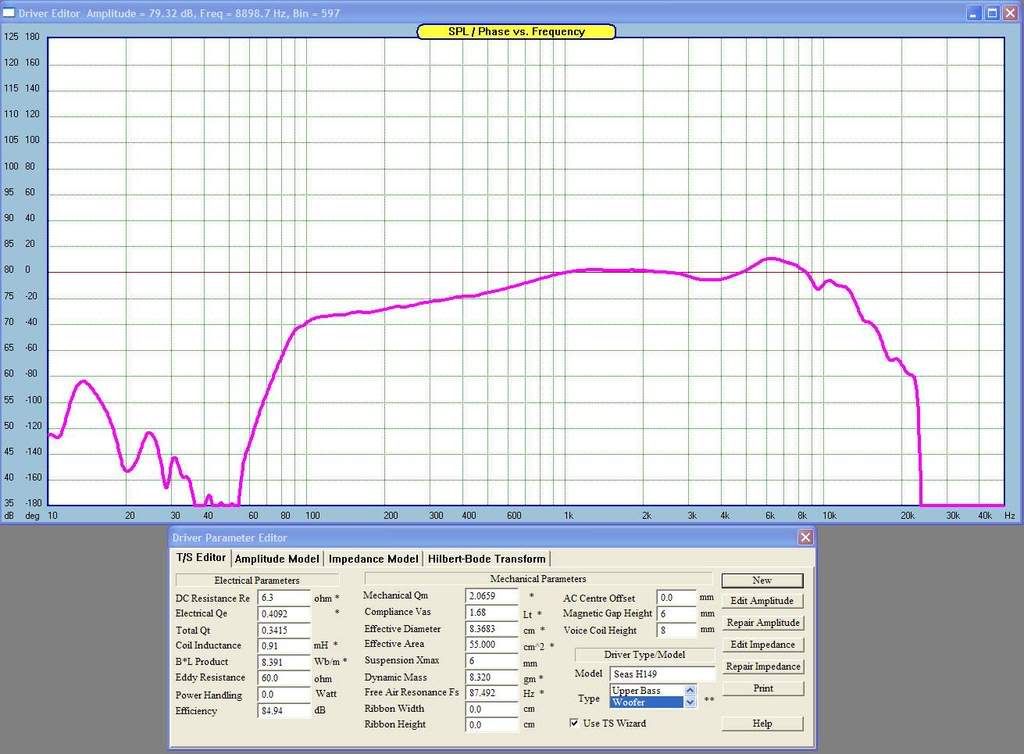
Below are the plots for the H225 tweeter impedance and frequency response. Measurements were gated.
H225 Impedance plot
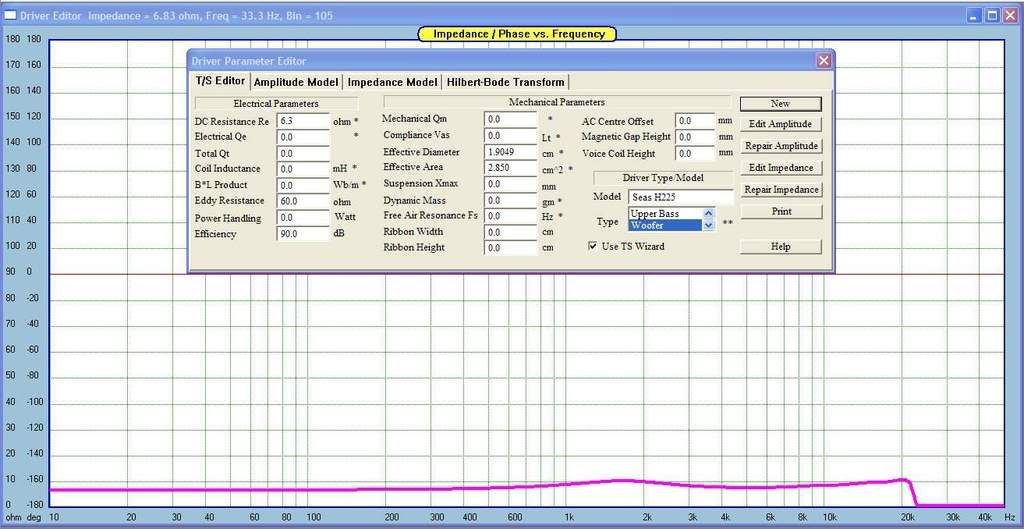
H225 Frequency Response plot
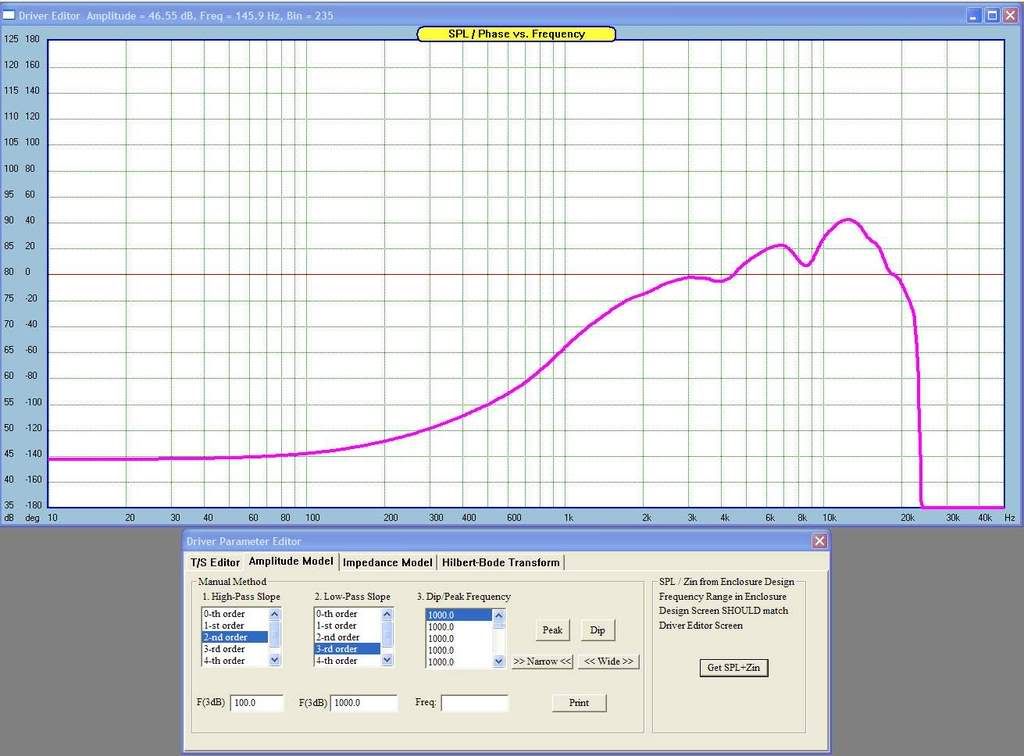
From the above frequency response it is apparent that I have problems ! I couldn't find any official published information on the H225. The closest I could find is the H737, but I don't know if these drivers are related. Seas claims that the H737 has a very flat response from 4000Hz to above 20000Hz. Unofficial TS parameters state a recommended frequency response of 4 - 20 kHz, Fs = 1700Hz, Sensitivity = 90dB. I have found one site saying of the H225, "a cheap polyamide-dome 19mm unit with remarkably good sound".
! I couldn't find any official published information on the H225. The closest I could find is the H737, but I don't know if these drivers are related. Seas claims that the H737 has a very flat response from 4000Hz to above 20000Hz. Unofficial TS parameters state a recommended frequency response of 4 - 20 kHz, Fs = 1700Hz, Sensitivity = 90dB. I have found one site saying of the H225, "a cheap polyamide-dome 19mm unit with remarkably good sound".
A reputable manufacturer like Seas would not produce a tweeter with such a bad frequency response. I therefore have to conclude that my tweeter measurements are garbage! But why?
I have tried various methods to eliminate measurement equipment. These include using a Behringer Eurorack mixer with phantom power in lieu of my ESI ESP1010 sound card's built in mic pre-amp (with phantom power), DIY mic in lieu of my Behringer ECM8000, Creative live sound card in lieu of the ESP1010. Nothing resulted in different results! I even measured a Seas 25TAFC/D tweeter I have and it also had the pronounced dip at 8600Hz.
I don't know what to make of all this!
Below is the relative gated overlayed frequency response plots of the H149 & H225. What is strange here is that the measurement was made with the exact same measurement setup. Shouldn't the tweeter response be even higher seeing that there is a 4dB difference in sensitivity between the woofer and tweeter?
H149 & H225 Relative Frequency Response plot
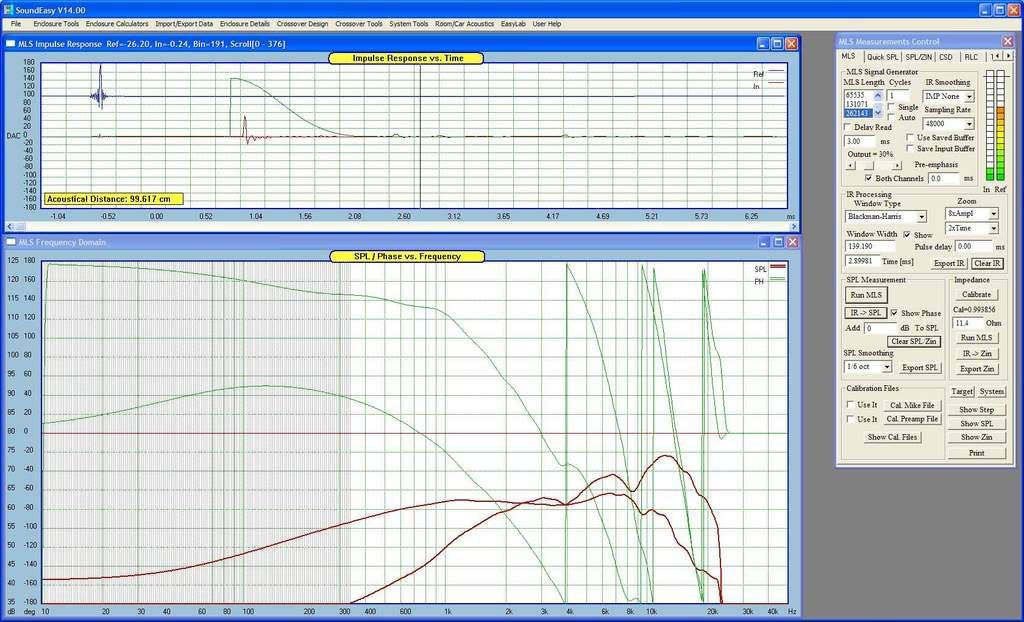
I have played a little with crossovers and managed the modeled electrical response below. I limited high pass optimization to 7kHz in order not to confuse the optimizer with the 8.6kHz and above "anomalies".
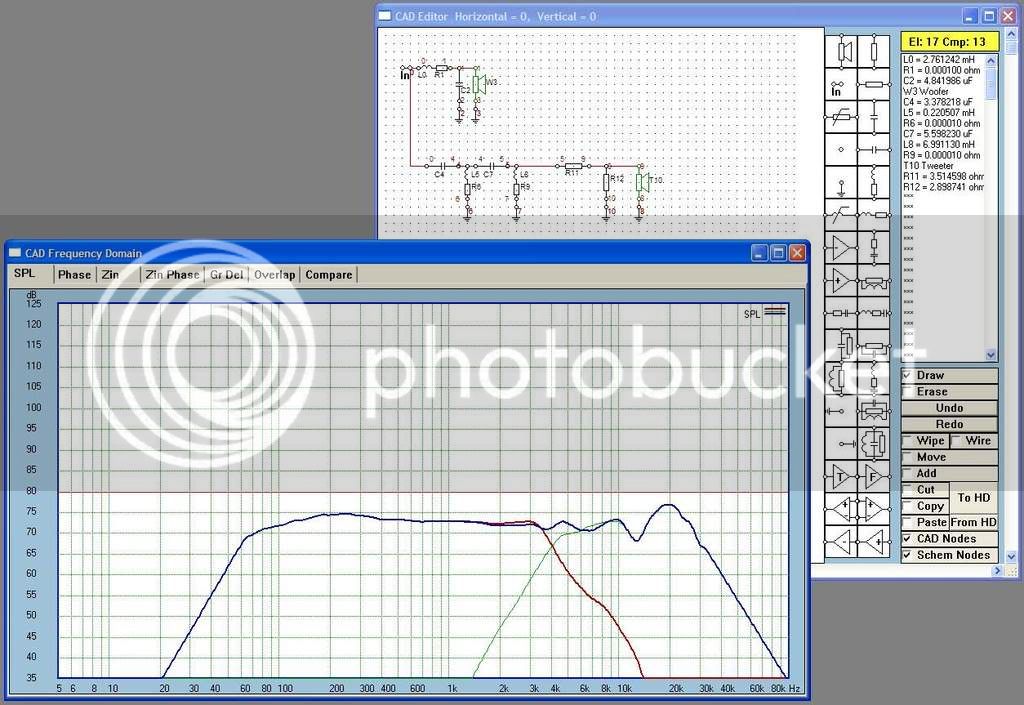
I crossed the H149 at 3500Hz at 18dB/oct. I removed the 2nd inductor because it came out to a very small value. Removing it had a negligible effect on the transfer function. I crossed the tweeter at 4200Hz at 24dB/oct. I added an L-pad in order to attenuate it a bit.
Listening to the system with this crossover using SE's digital filter feature left me unimpressed to say the least.
I expected better bass extension - even with the baffle step compensation. Midrange is muffled. Top end is sharp and brittle. It sounds crap!
I don't know if the H149 can be used as a woofer - maybe it is just a midrange driver?
Could some of the more experienced members perhaps shed some light on this mess?
Help would be appreciated.
Gerhard
First some background...
I bought these drivers (Seas H149 & H225) several years ago - without knowing anything about DIY speaker design. I put them in a 3.5l ported box based on a rudimentary design using Speaker Workshop IIRC. Needless to say the performance were less than stellar!
Here are pictures of the drivers:
Front view

Back view

Since then I have upgraded my speaker DIY paraphernalia to the extent that I can now design and build proper speakers (tools wise speaking that is...). I have spent the last several months studying speaker design in general and Sound Easy in particular. As a result I have a lot of theoretical knowledge but very little practical experience, hence the reason for this post.
My idea was to build small surround sound speakers for my HT and since Seas claimed a usable frequency range of 45-5000Hz for the woofer, I thought they'd be able to go down quite low.
I have decided to revisit my "design" (more a "klip in die bos" TBH) using my new tools and knowledge. Here are the results so far...
I started by measuring the H149's using SE's Easylab which includes a MLS tool in order to obtain T/S parameters. The measurements were done with the driver magnet clamped to the edge of a large desk in a vertical position. The reference resistor was 11.4 Ohm. I used the delta V (volume) approach using a 3l enclosure.
Below is the free air impedance plot with the extracted T/S parameters.
H149 Free Air Impedance plot

Measured T/S parameters

Seas Published T/S parameters

As can be seen there are significant differences between the published vs measured parameters. I based the design on the measured parameters.
I decided on a ported 2l box tuned to 85Hz (This is at the measured driver resonance but I have to get at least some bass extensions - or is this my first mistake?). The actual box is 2.5l to allow for driver motor structure, port volume and crossover components. A 25% increase in box volume is significant but so is the H149's motor! (second mistake?)
Below are the measured impedance and frequency response plots of the H149 mounted in the test enclosure with fiberglass damping (about 2.5cm thick) applied to the sides, top and bottom. The frequency response plot was arrived at by splicing together the following measurements:
1. Gated far field
2. Near field
3. Port
4. Baffle step correction
The frequency response was tailed by performing a Hilbert-Bode transform.
H149 Boxed (2.5l) Impedance plot

H149 Boxed (2.5l) Frequency Response plot

Below are the plots for the H225 tweeter impedance and frequency response. Measurements were gated.
H225 Impedance plot

H225 Frequency Response plot

From the above frequency response it is apparent that I have problems
A reputable manufacturer like Seas would not produce a tweeter with such a bad frequency response. I therefore have to conclude that my tweeter measurements are garbage! But why?
I have tried various methods to eliminate measurement equipment. These include using a Behringer Eurorack mixer with phantom power in lieu of my ESI ESP1010 sound card's built in mic pre-amp (with phantom power), DIY mic in lieu of my Behringer ECM8000, Creative live sound card in lieu of the ESP1010. Nothing resulted in different results! I even measured a Seas 25TAFC/D tweeter I have and it also had the pronounced dip at 8600Hz.
I don't know what to make of all this!
Below is the relative gated overlayed frequency response plots of the H149 & H225. What is strange here is that the measurement was made with the exact same measurement setup. Shouldn't the tweeter response be even higher seeing that there is a 4dB difference in sensitivity between the woofer and tweeter?
H149 & H225 Relative Frequency Response plot

I have played a little with crossovers and managed the modeled electrical response below. I limited high pass optimization to 7kHz in order not to confuse the optimizer with the 8.6kHz and above "anomalies".

I crossed the H149 at 3500Hz at 18dB/oct. I removed the 2nd inductor because it came out to a very small value. Removing it had a negligible effect on the transfer function. I crossed the tweeter at 4200Hz at 24dB/oct. I added an L-pad in order to attenuate it a bit.
Listening to the system with this crossover using SE's digital filter feature left me unimpressed to say the least.
I expected better bass extension - even with the baffle step compensation. Midrange is muffled. Top end is sharp and brittle. It sounds crap!
I don't know if the H149 can be used as a woofer - maybe it is just a midrange driver?
Could some of the more experienced members perhaps shed some light on this mess?
Help would be appreciated.
Gerhard
